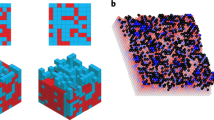Abstract
The main regularities of variations in the thermodynamic properties of components of cubic vanadium carbide, depending on the composition in the region of homogeneity, are investigated experimentally. It is believed that these regularities are inherent only to metal oxides. This serves as the basis for the concept that passivation during the corrosion of metals occurs due to the formation of surface metal oxide whose composition corresponds to the maximum concentration of oxygen in the region of homogeneity. The thermodynamic stimulus of corrosion is in this case reduced to almost zero.
Similar content being viewed by others
References
N. P. Zhuk, Theory of Corrosion and Protection of Metals (Metallurgia, Moscow, 1976) [in Russian].
N. D. Tomashov and G. P. Chernova, Passivity and Protection of Metals Against Corrosion (Nauka, Moscow, 1965; Plenum Press, New York, 1967).
H. Okada, S. Sekino, Y. Hosoi, and T. Murata, in Copper in Ferrous Metals (Metallurgiya, Moscow, 1988), p. 67 [in Russian].
I. L. Rozenfeld, Atmospheric Corrosion of Metals (Akad. Nauk SSSR, Moscow, 1960; NACE, Houston, TX, USA, 1972).
L. Onsager, J. Phys. Rev 37, 405 (1931).
E. Fromm and E. Gebhardt, Gases and Carbon in Metals (Springer, Berlin, 1976; Metallurgiya, Moscow, 1974).
V. I. Alekseev and Yu. N. Surovai, Zavod. Lab. 31, 1356 (1965).
V. I. Alekseev and E. M. Parnis, Zavod. Lab., No. 10, 1207 (1972).
V. I. Alekseev and I. Ya. Grechnaya, in Problems of Science of Metals and Physics of Metals, Thematic Collection No. 2 (Metallurgiya, Moscow, 1973), p. 190 [in Russian].
V. Aronson and J. Sadofsky, J. Inorg. Nucl. Chem. 27, 1769 (1965).
D. F. Elliot, M. Glaizer, and V. Ramakrishna, Thermochemistry for Steelmaking (Addison-Wesley, Reading, MA, 1960–1963; Metallurgiya, Moscow, 1969).
Author information
Authors and Affiliations
Corresponding author
Additional information
Original Russian Text © V.I. Alekseev, M.M. Perkas, V.S. Yusupov, G.Yu. Lazarenko, 2013, published in Zhurnal Fizicheskoi Khimii, 2013, Vol. 87, No. 8, pp. 1391–1397.
Rights and permissions
About this article
Cite this article
Alekseev, V.I., Perkas, M.M., Yusupov, V.S. et al. The mechanism of metal corrosion passivation. Russ. J. Phys. Chem. 87, 1380–1385 (2013). https://doi.org/10.1134/S0036024413080049
Received:
Published:
Issue Date:
DOI: https://doi.org/10.1134/S0036024413080049



